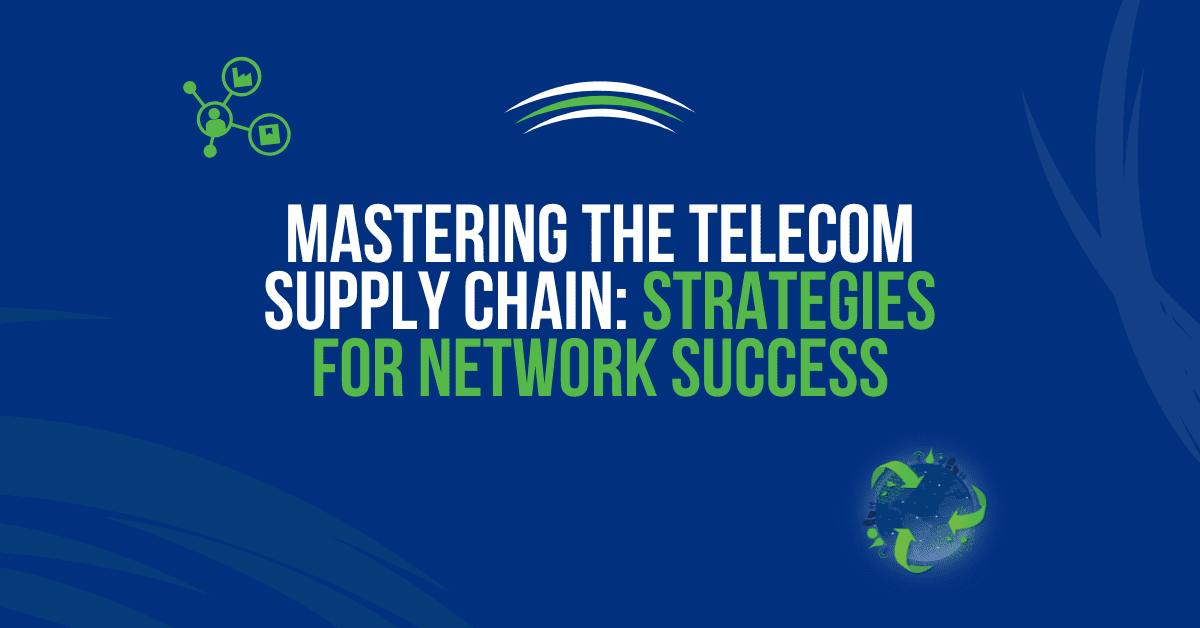Networks are facing major challenges when it comes to maintaining inventories and managing equipment stock. The semiconductor shortage and the Covid pandemic proved no-one knows what’s around the corner, and if your network wasn’t keen on the long-drawn-out lead times and price hikes that followed, you’ll find this page helpful.
But those aren’t the only concerns that might be causing you a headache right now; what about overstocking? Or budget constraints? Or simply the time it takes to communicate with all the different manufacturers to gather the quotes you need? If you’re feeling the pressure in this tricky telecoms supply chain, this short read shows you how to take back control.
In this blog, we’ll look at the key supply challenges that telecoms networks are facing, and explore how you personally can regain power, put predictability back into your equipment procurement, and make the whole process a lot less stressful.
Let’s dive in.
Supply chain conundrum #1: time wasted communicating with countless different manufacturers
How to streamline communication and still get the same great products your network needs
One of the most persistent challenges equipment teams grapple with is the intricate process of engaging with multiple manufacturers. The conventional approach involves extensive communication, back-and-forth negotiations, and that time-consuming task of collecting quotes from various Original Equipment Manufacturers (OEMs) to make informed decisions and get the right kit at the right price.
It’s a pretty strenuous procedure, and can often result in a significant drain on resources and time. What if there was a way to streamline the process and bring about a more efficient means of sourcing (and still get the same great quality products)?
Shields MarketPlace totally alleviates those complexities of sourcing telecoms equipment. Imagine a central hub where you can seamlessly get the quotes you need in one place (and enjoy more competitive pricing too). What’s more, you can see your own network’s entire inventory first too. And thanks to the rigorous testing that all decommissioned equipment goes through before it hits MarketPlace, you can find virtually all the same kit, from all the same manufacturers, with all the convenience of a single platform.
Supply chain conundrum #2: managing storage and preventing over or understocking
Improving visibility and reducing lead times in one go
Managing storage without turning your warehouses into a chaotic mess of overstocked equipment is a delicate art in telecoms. Those standard 8+ week lead times for kit leave even the most meticulous of buyers tiptoeing the inventory tightrope, and if you’ve ever fallen foul of accidental double-ordering, you’ll appreciate it’s a real problem.
Not just in terms of storage space either, but unused stock sitting in warehouses means money’s being left on the table too – not exactly the highlight of any budget meeting.
With a transparent, dynamic ordering system and just-in-time solution, you can wave goodbye to the overstock understock tango and enjoy more OPEX (operational expenditure) in your network’s pocket. MarketPlace is the world’s largest inventory of used network equipment and as such, lead times are as little as 5 days for smaller orders. Even on the biggest orders, we aim to deliver within 25 days of purchase. The benefits?
- You don’t get stuck with a surplus of equipment
- You don’t have to wait months to get the kit you need
- You have access to extensive stock on hand
- You enjoy full visibility on what’s available and where within your network’s own footprint
- You free up budget and warehouse space in one fell swoop
Supply chain conundrum #3: ESG pressure’s growing, but you can’t control your suppliers’ sustainability processes
How can you achieve sustainability targets while still sourcing the materials your network needs?
In the ever-evolving landscape of corporate responsibility, networks are finding themselves under increasing pressure to align with Environmental, Social, and Governance (ESG) standards. The demand extends beyond day-to-day operations too, to the very core of how equipment is procured.
While you might not be able to control what your suppliers are doing to promote sustainability, your network does have an opportunity to contribute by re-evaluating procurement strategies. By opting for quality used telecoms equipment, networks not only cut costs but also significantly reduce the need for new manufacturing and the environmental impact of precious metal mining. As a demonstration, last year we:
- Helped the telecoms industry avoid 16 million kg of CO2 emissions that would have been produced through manufacturing
- Recycled more than 4 million kilos of telecoms equipment that was past its useful life
- Recouped the cost of precious metals through recycling, generating an average recycle revenue of €2,379,616 for each network that owned the equipment
Click here for more reasons to buy used
Beyond the financial advantages of sourcing through platforms like MarketPlace, there’s a compelling environmental narrative too. Your network:
- Lowers its carbon footprint, contributing to a cleaner, greener future
- You’ll even get the data you need for reporting under the new Corporate Sustainability Responsibility Directive (CSRD)
- Protects the planet and your own brand
Supply chain conundrum #4: budget constraints
How to lower your costs while your suppliers increase their prices, and maintain quality at the same time
Budget constraints form a perennial challenge for networks to navigate, and as costs continue to rise, sourcing equipment is getting more and more expensive. And yet there’s such a simple solution that some networks continue to overlook.
Enter decommissioned equipment; the paradigm-shifting solution that empowers networks to forego budget limitations by adopting the circular economy and investing in quality at a more affordable price. Smart networks are buying used, not just to maximize budget allocations, but to curb capital and operational expenses too.
MarketPlace has the world’s largest inventory of used network equipment, which means our demand forecasting is unrivalled when it comes to decommissioned kit. As a result, networks can depend on a steady supply of standardized, high-quality parts to match anticipated demand, and source at a fraction of the cost of buying direct from the OEM.
Supply chain conundrum #5: unpredictable delays that throw everything up in the air
Networks can avoid worrying about the future by maximizing the past
One of the most critical recent challenges for telecom operators was the shortage of semiconductors. Tiny but vital components, essential for the production of network equipment, and when those chips fell into short supply, the entire manufacturing process was disrupted, leading to increased costs and lead times – some of which were as long as a year!
While we can’t give you a magic wand to wave that means you can predict the next big disruption, we can help you protect against the fall-out. During the chip shortage crisis, we saw a huge increase in demand for used telecoms equipment – because, if you don’t have to rely on semiconductors, why do it?
Why not look for alternative used equipment that does the same job, but doesn’t rely on those latest parts that are open to shortages and ensuing price increases? And with robust testing and quality control, you can ensure that you get just as long a lifespan from used equipment as you would buying new from the OEM (Original Equipment Manufacturer), and you don’t fall foul of unpredictable delays.
If you’ve been feeling the pressure and you like the idea of lifting the weight and taking back control of your supply chain, we’d love to introduce you to MarketPlace properly. For help strategizing how your network can reduce costs and carbon emissions, maximize budgets and streamline telecoms equipment procurement, get in touch here or book a demo of MarketPlace below.


